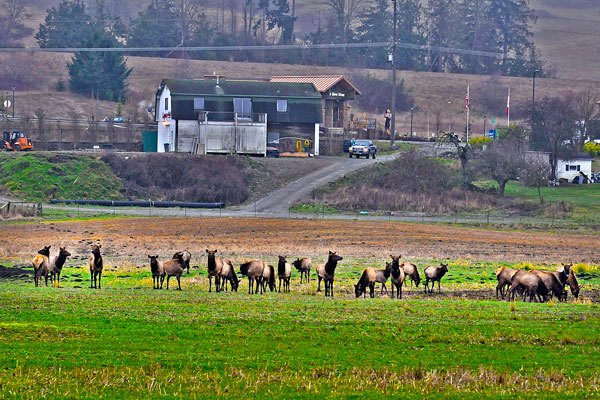Elk culling, the always controversial means of reducing the number of elk in the Sequim herd, is now under way.
Mick Cope, Regional Wildlife Program Manager for Region 6, which includes the entire peninsula, said he prefers to use the term managing rather than culling, saying it better reflects the program’s planning and purpose. “We’re trying to remove and reduce the number of animals,” he said.
Cope said the Sequim elk herd has grown “bigger than it should be.” As a result, “the farmers in the area have been feeling an impact to the bottom line.”
“We’re not trying to eliminate (the herd), that’s for sure,” he said.
In an interview in 2012, Sgt. Eric Anderson, an agency enforcement official, told the Gazette, “We understand how important the herd is to the city of Sequim. We know some people are going to have some really strong feelings about this.”
“But,” he added, “we have to keep the herd at a number where we’re not having agricultural damage.”
He noted that that the elk population “isn’t stagnant.” Left unchecked the population would “grow exponentially.”
“They don’t have any natural predators,” Anderson said. “And they’re sitting there in some of the best fields in Washington.”
Setting goals
The program this year has the same goals as in the past. First and foremost, that means limiting the damage to crops while ensuring visitors and residents can still enjoy viewing the herd.
“We’re trying to strike that balance,” said Cope.
He said his department has a goal of bringing the number of antlerless elk north of U.S. Highway 101 to around 20. He said the herd is largely a mixture of cows, calves (too young to have been sexed) and “spikes” — young bulls.
One or two of the more mature bulls will travel with the cows, and more arrive and leave in the fall.
Cope said the issue has been ongoing for years, but may be growing more acute as both elk and human numbers increase.
He added there’s another important issue at work: “Elk have have learned that farms provide really good, nutritious forage.”
“We have maybe 20-25 places in Region 6 alone where we have crop damage,” he said.
He added that the agency’s duty is spelled out in the law. “They’re causing damage to crops, so the Legislature says we have to respond. We have to sometimes also compensate damage claims,” he added.
Killing an elk isn’t the first option, but “non-lethal hazing” often has little impact.
He said the current effort likely will continue until March.
Working with the farmers
Cope said their efforts include working with local farmers, including Nash Huber and the Smith family, which owns Maple View Farm.
Troy Smith, who oversees Maple View’s 650-acres crop farming operation, said the cooperation extends to allowing hunting access on the company’s property in the Port Williams area.
He confirmed the elk cause extensive damage to Maple View crops — “thousands and thousands of dollars a year.”
He estimated they had lost $20,000 in 2013 alone.
“There isn’t much profitability in farming,” he said. “That takes a big hit.”
Smith said his family was farming north of Sequim long before the elk arrived.
“In the last 10 or 15 years they’ve come down here and basically taken up residence on our crop land,” Smith said.
Prior to that time, they mostly spent their time south of Highway 101.
“The development pressure on Bell Hill, Happy Valley and other places took away their natural habitat,” Smith said.
Once they moved north, they struck gold.
“We grow very high quality feed for dairy cattle and the elk love it,” Smith said.
“We go out and try to move them off, but the problem is that they come back in the middle of the night.”
Smith said the elk are smart — smart enough to stay in the trees surrounding the crop land, then feed at night.
“I think the reduction in the herd number is the right way to go,” he said. “For the near future that’s the right management tool.”
Anderson estimated the current elk population on the peninsula at between 10,000 and 12,000. Most of those are found on private land, he said.
Reach Mark Couhig at mcouhig@sequimgazette.com.



